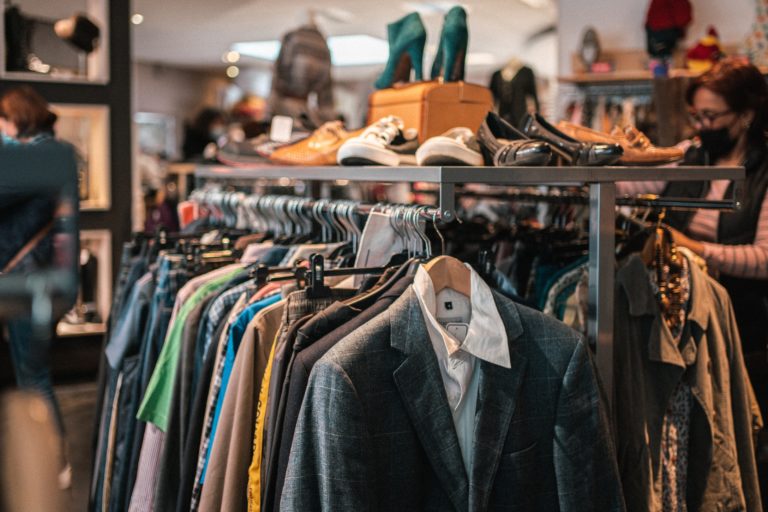Unlike “recycled” trends, which are suspiciously reminiscent of the 80s or 90s, our clothing itself is unfortunately usually not particularly durable.

What impacts does fast fashion have on the environment?
On the European Parliament’s website, the environmentally harmful effects resulting from production and consumption within the textile industry are clearly presented. These can be roughly divided into four major categories:
- High water use (especially for cotton cultivation)
- Water pollution: Microfibers and chemicals enter the oceans
- Emissions of greenhouse gases such as CO2
- Clothing waste
Water use
The cultivation of natural fibers for textile production is very resource-intensive: The production of a single cotton shirt, for example, requires 2700 liters of fresh water, which is roughly equivalent to the amount a person drinks in 2.5 years.
In the Waterplaybook of the NGO drip by drip, which works to protect water bodies in connection with the textile industry, you can calculate a personal “water footprint” based on the contents of your own closet to illustrate this effect.
Water pollution
With regard to negative impacts that clothing production can have on water bodies, chemicals dumped into rivers by manufacturing companies become relevant on the one hand, and on the other hand the synthetic fibers contained in textiles, which e.g. release microplastics during the washing cycle.
Greenpeace, for example, has been able to clearly demonstrate that certain textile producers in China dump harmful chemicals produced during the manufacturing processes unfiltered into nearby rivers. This lowers water quality and has a negative impact on people, animals and nature in the surrounding area.
In the course of the Detox-My-Fashion campaign, however, individual textile manufacturers in cooperation with Greenpeace have shown that fashion can be done differently: A report on the progress of the program from 2021 describes the progress that the participating companies have been able to achieve with regard to the goal of “Zero Discharge” (= no release of harmful chemicals) by checking the entire supply chain, including the manufacturing conditions, instead of just checking the end products for harmful substances, and adjusting accordingly.

Researchers disagree on the exact amount of microplastics in water bodies that can be attributed to the washing of textiles. However, it is clear that the contribution to the total microplastic load is between 16% and 35% and that the textile industry therefore contributes significantly to the problem.
Moreover, a double problem arises with fast fashion: not only are large quantities of textiles produced, but they also use predominantly inexpensive synthetic fibers, which in turn release microplastics.
Synthetic fibers or cotton?
Although it is often assumed that cotton as a natural fiber is fundamentally more environmentally friendly in the production of textiles, this cannot be said across the board. It is true that the microplastic problem does not exist to the same extent as with polyester and similar materials. On the other hand, the already mentioned high water usage in the cultivation of cotton and the pesticides used must be taken into account.
Emissions
The 2020 Fashion on Climate study conducted by McKinsey & Company examined and evaluated various environmental impacts of the fashion industry. Among other things, it found that 2.1 billion tons of greenhouse gas emissions were attributable to the textile industry in 2018, which corresponds to 4% of global emissions. That doesn’t sound like a particularly high proportion at first – but when put into perspective, the global fashion industry contributes just as much to CO2 emissions as Germany, the UK and France put together.
According to the study, about 70% of the emissions came from the production itself, while the remaining 30% resulted from the sale, use and disposal of the clothing.

Clothing waste
According to reports from the European Parliament, almost 26 kilos of clothing are bought per person in the EU every year – and 11 kilos are thrown away again. Although there are theoretically possibilities of recycling clothing waste, 87% of old clothes are disposed of in the “traditional” way: they end up in landfills or incinerators. The fact that these masses of waste are anything but environmentally friendly certainly needs no further explanation.
What has to change?
The WWF calls for a transformation of the textile industry, which unfortunately has so far only been implemented by a few isolated producers. Greenpeace sees responsibility for supply chains as the most important aspect of such a transformation, which in turn requires legal regulations.
But in addition to politically controlled measures, we as consumers can also take action: Instead of continuing the cycle of consumption and throwing away, we can buy used clothing and resell or donate the clothes we don’t need anymore.
In addition to formats such as clothing swaps among friends, fashion flea markets and second-hand stores, some of the major online providers have now also discovered this business area for themselves and offer (similar to refurbished electronics) quality-tested used clothing with all the conveniences of online shopping on their platforms.
Among other things, the European Parliament recommends that consumers and manufacturers change their mindset to “slow fashion”: the philosophy is aimed at buying less clothing of higher quality overall and keeping it for longer. Another idea presented is the fashion-as-a-service model, which is not very well known yet, at least in Germany: the idea is to rent or lease high-quality clothing instead of buying it. On the consumer side, this spreads the acquisition costs over a longer period of time and also means that there is always variety in the closet, even without constant new purchases.

Conclusion
There is undoubtedly a need for political action to somewhat mitigate the negative environmental impacts of the textile industry through regulation. But creating new laws takes time. Individual companies can, of course, already set higher standards for themselves without strict regulations, and orient their business models and production techniques to these standards in a more environmentally friendly way. For manufacturers, however, this is always in conflict with the aim of maximizing profits, so that so far only individual companies have taken this route. Even if, against the backdrop of this huge industry, it may not seem as if we can actually make a difference: As customers, we can at least help set an example with our decisions for (or especially against) products from individual companies. Because where there is a demand for climate-friendly clothing, there will also be a supply over time – and where the demand for fast fashion may decrease, there will also be economic reasons for manufacturers to rethink their processes.



